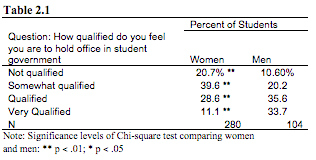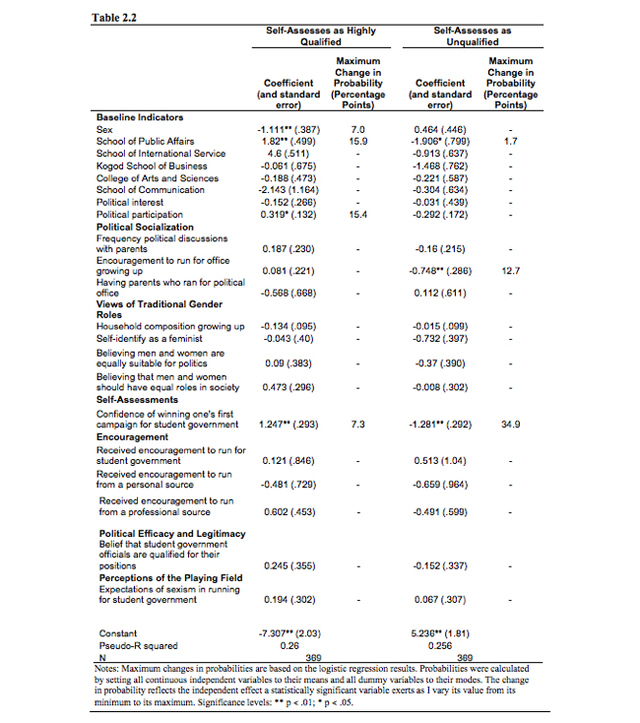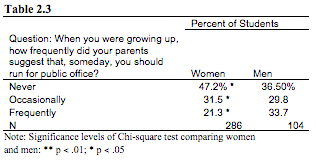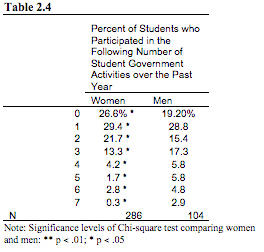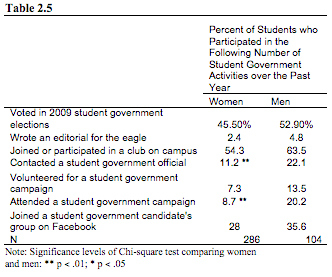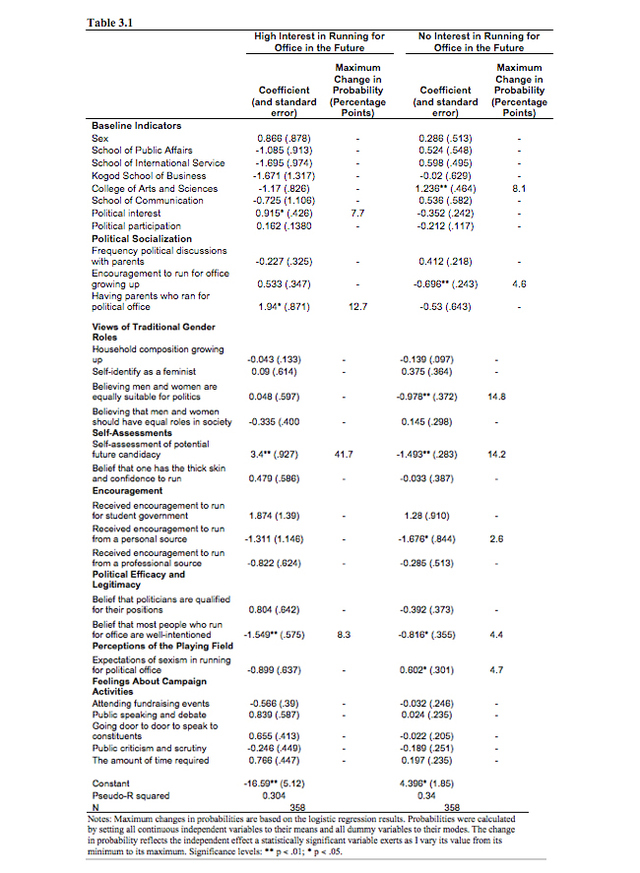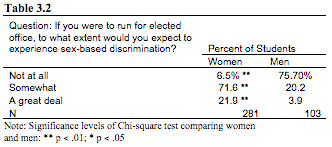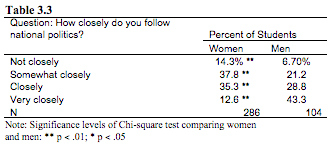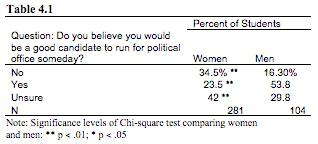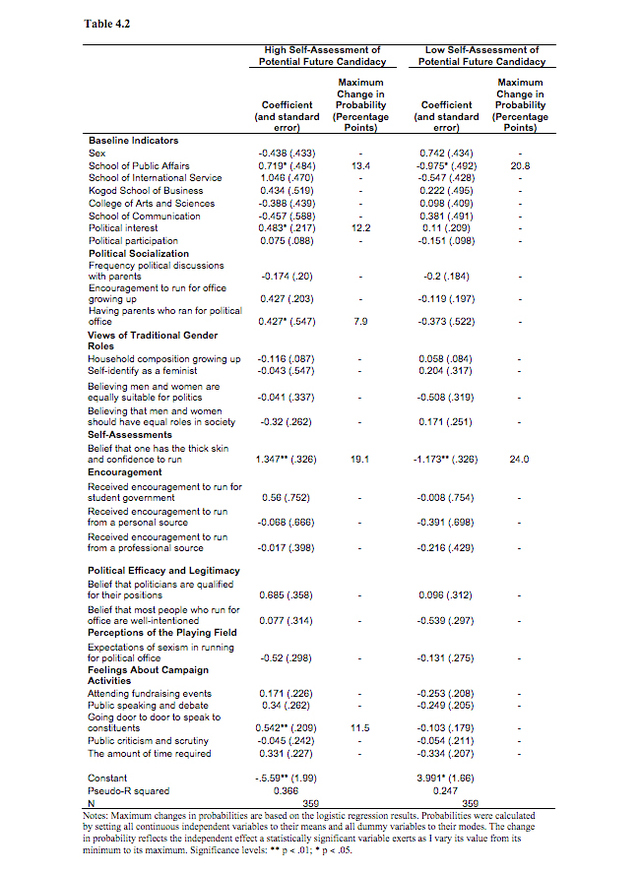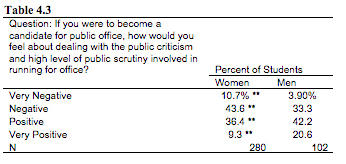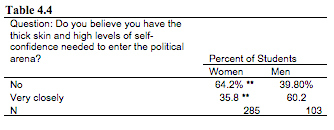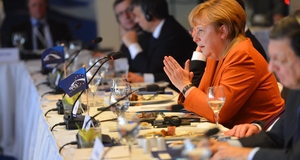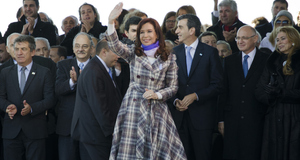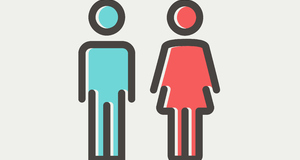From Clocks and Clouds VOL. 2 NO. 1A Vote of No (Self)-Confidence: Gender, Socialization, and Political Ambition
By
Clocks and Clouds 2012, Vol. 2 No. 1 | pg. 1/1
IN THIS ARTICLE
KEYWORDS
AbstractIn light of women's underrepresentation in student government, this paper investigates to what extent levels of political ambition differ between male and female students and why at American University. Current literature regarding women's underrepresentation in elected office suggests that gender differences in levels of political ambition in political pipeline careers explain much of women's lower likelihood to run for and serve in elected office. This body of scholarship finds that women's political ambition is significantly diminished by traditional sex-role socialization and traditional views of the political realm. Because research shows that participation in student government and political activities, such as volunteering for a campaign, in young adulthood significantly increases high-level civic participation later in life, this study fills a gap in current research by analyzing the impact of socialization and traditional views on levels of students' political ambition at American University. IntroductionAccording to the American University website, the Princeton Review named American University (AU) the nation's second most politically active campus in 2012; 72 percent of students report that "keeping up-to-date with political affairs" is important to them. The university boasts impressive reputations for its School of International Service and School of Public Affairs. It also reports that women make up roughly 59 percent of the student body. Yet female students occupied only 10 out of 32 elected student government positions in the 2011-2012 academic year, and only 13 of the 47 candidates running for office in 2011 were women. These numbers are strikingly similar to the 17 percent of women in the U.S. Congress and the 12 percent of female governors in the United States (CAWP 2012). The dearth of female students in student government at American University, despite their overrepresentation in the overall population, suggests significant gender differences in political ambition, or the desire and intent to run for political office. Based on the results of a survey of AU students, this research provides empirical evidence of the gender gap in political ambition and sheds light on the reasons it exists. I find that while sex does not always directly predict political ambition among students, significantly gendered differences exist within other factors that more directly predict ambition. Women's political ambition is substantially depressed by lowered self-assessments of their qualifications to serve in office, and a less politicized upbringing. Determining the factors at work in hindering political ambition in female students at American University is important for several reasons. First, the fact that women are much less likely to run for office even at the college level indicates that a number of factors political scientists often propose to explain women's underrepresentation in elective office are insufficient. Because issues like fundraising capabilities, sexist media coverage, and family responsibilities are not applicable in studies of student government, the persistent dearth of women running for and serving in student government suggests that other factors are at work. The underrepresentation of women in student government and political office may indicate that women, in general, perceive leadership as either unappealing or unattainable. In light of the fact that the extent to which citizens feel they could make a successful run for elective office is an indicator of a democracy's political legitimacy, gender differences in political ambition are a significant problem. By translating Lawless and Fox's (2005; 2010) work to the college level, this study seeks to add to the pool of scholarship dedicated to gender and political ambition by reaching respondents while they are in early phases of formulating ambition and views of elected office. Conceptual FrameworkPolitical ambition is central to the study of political science because of its relationship to democratic governance and political legitimacy. The degree to which citizens are willing to participate in politics or run for public office is a key measure in assessing the legitimacy of democracy in the United States (Fox and Lawless 2010; 2005). Further, as Thomas (1998) argues, "A government that is democratically organized cannot be truly legitimate if all its citizens . . . do not have a potential interest in and opportunity for serving their community and nation" (see also Mansbridge 1999; Verba, Schlozman and Brady 1995). If interest in seeking office is restricted to citizens with certain demographic profiles, then serious questions emerge regarding both descriptive and substantive representation (Lawless and Fox 2010; 2005). In this study, I develop and examine early political ambition, or potential interest in office seeking, a type of ambition that precedes the actual decision to enter a specific political contest. Research finds that political ambition in students and participation in activities like student government greatly increase an individual's likelihood of running for office later in life (Glanville 1999). For this reason, this study is tailored to analyze political ambition with regard to both public office and student government. Literature ReviewExisting Explanations: Discrimination, the Pipeline, the Institution, and FamilyThroughout the 1970s and 1980s, most political scientists explained the lack of women in politics as a result of gender-based discrimination. In other words, that the American electorate did not support women candidates (Boxer 1994; Kirkpatrick 1974). Survey data from those decades reveal that, indeed, the vast majority of the American electorate believed that men were better suited emotionally for politics (Lawless and Fox 2004, Fig. 2.2). In 1992, however, the so-called "Year of the Woman," the significant increase in the number of women running for and elected to political office substantially discredited the "discrimination explanation" (Dolan 1998). A number of studies demonstrating that women's electoral success rates are comparable to men's (Dolan 1998) and polling data showing that 90 percent of Americans would be willing to vote for a female presidential candidate (Frankovic 2008) elicit further skepticism over the extent to which the underrepresentation of women in elected office can be attributed to discrimination in the electorate. While scholars in the field have, by and large, rejected the "discrimination explanation," they have turned to a number of institutional explanations in its place. One such explanation contends that women are underrepresented in elective office because they are underrepresented in the careers that typically lead to running for office – law, business, and education. Darcy, Welch and Clark (1994) contend that women are typically relegated to "pink ghetto" occupations, such as clerical work, nursing, and teaching at the elementary school level – occupations that do not generally lead to running for office. This explanation implies that as women become more numerous in so-called pipeline careers, their numbers will also increase in elective office. Women have made significant progress in the workforce in recent decades. Despite this progress, however, women are still significantly underrepresented in the top tiers of law, academic and business careers (Lawless and Fox 2005). The incumbency advantage also hinders women's capacity to make substantial gains in representation (Darcy, Welch and Clark 1994). The vast majority of incumbents seek reelection. Among those who do seek reelection, success rates top 90 percent (Darcy, Welch and Clark 1994). Because men make up the majority of incumbents, the political opportunities for potential women candidates are limited to open seat elections and weak incumbents (Lawless and Fox 2005). In addition to these institutional barriers to entry, social scientists point a number of social barriers to explain women's underrepresentation in elected office. One of such explanation holds that because women are still primarily responsible for the bulk of household and child care tasks, they find the prospect of running for and serving in political office less feasible than do men, who are typically unencumbered by such obligations (Lawless and Fox 2010). Despite the increase in two-income households in recent decades, and the slackening of rigid sex roles, a number of surveys continue to find that women spend twice as many hours as men on household and child care tasks (Lawless and Fox 2010). While this explanation likely plays some role in women's desire and ability to run for and serve in political office, the extent to which the correlation exists is unclear (Lawless and Fox 2005, 59). Lawless and Fox (2005, 73) find considerable qualitative evidence to support the notion that women's duties as primary caretakers of the household significantly constrict their capacity to seriously consider running for office, pointing out that women continue to be "forced to reconcile their careers and families" in a way that men are not. However, that qualitative evidence is complicated by the fact that their quantitative analysis finds that family roles and responsibilities do not significantly predict whether an individual considers running for office (Lawless and Fox 2005, 67). A New Take: Exploring Gender Differences in Political AmbitionFinding these explanations insufficient in light of the growing evidence against them, Lawless and Fox (2010; 2005) develop the "political ambition" explanation, which argues that women's underrepresentation in politics persists because they do not run for office as often as men. Taking into consideration Darcy, Welch and Clark's eligibility pool explanation, Lawless and Fox sample men and women from the eligibility pool – lawyers, business executives, educators, and political activists – and find that women are less likely than similarly situated men to consider running for office. They attribute the gender gap in political ambition to three manifestations of traditional gender socialization. First, notions of traditional family roles impress upon both women and men the expectation that women should bear the responsibility for a majority of household and child-raising tasks. Myriad empirical studies continue to find that married women in two-career households continue to perform 60-70 percent of household tasks (Achen and Stafford 2005; Bittman and Wacjman 2000). Because women have an additional expectation to fulfill family responsibilities, many women find balancing careers with home life challenging, and perceive the idea of running for office as an unappealing "third job" (Lawless and Fox 2005). Because men do not experience family responsibility expectations to the same extent women do, entering politics does not impose on their capacity to fulfill their personal and professional obligations. Second, because existing governmental institutions were created by men and are controlled by men, they embody and perpetuate an "ethos of masculinity" that applauds and rewards displays of masculinity, stymieing the integration of women into politics (Lawless and Fox 2005, 9). For example, Lawless and Fox (2005, 9) point out that when individuals consider the prospect of running for office, "they must rely on the support of numerous political institutions" – most which are dominated by men. Lawless and Fox (2010; 2005) find that receiving encouragement to run for office from actors within these institutions is the most significant predictor of seriously considering running for office. They determine that while both men and women are much more likely to run for office when they are recruited, in reality, women are much less likely to be recruited. Third, a "gendered psyche" where women overlook their marginalization in the public sphere in favor of a patriarchal system that makes many women feel protected and valued in their traditional roles makes politics a suitable career for men, but one that "does not even appear on the radar screen for many women" (Lawless and Fox 2005, 10-11). Gendered socialization leads men and women to gravitate toward traditionally male and female occupations. A number of studies on gender socialization find that women tend not to be socialized to develop many of the traits that are admired and rewarded in politics, such as confidence, assertiveness, and self-promotion. Lawless and Fox's (2010; 2005) study finds that women are much more likely to doubt and understate their qualifications to serve in elected office, providing compelling empirical evidence of these tendencies. Although Lawless and Fox provide an excellent investigation into early political ambition and the early political socialization factors that contribute to ambition, because their study focuses on men and women who are already established in careers within the political pipeline, they are not able to examine the gender dynamics of political ambition among adolescents and young adults. In their concluding chapter, Lawless and Fox (2005, 154) reiterate the importance of political socialization in the development of political ambition, remarking, "For most people, choosing to run for office is not a spontaneous decision; rather, it is the culmination of a long, personal evolution that often stretches back into early family life." They point out that "Women's greater sense of self-doubt pertaining to their abilities to enter the political arena is one of the most complex barriers to their emergence as candidates," and calls for researchers to "explore the origins of these doubts that affect whether and how women and men come to view themselves as candidates" (Lawless and Fox 2005, 154). Few studies have attempted to answer that call. In one such study, Smith (2007) finds a number of similarities among the concerns of men and women regarding running for political office. She finds that a greater concern for self-presentational issues (which she defines as their level of comfort in subjecting themselves to public scrutiny) relative to logistical issues (those concerning the actual act of running a campaign) makes women and men less likely to be ambitious and that women and men benefit from encouragement to consider running for office. Smith concludes, however, that self-presentation and impression management issues rank higher as obstacles for young women than for young men. Moreover, men and women differ in their perception of impression management obstacles to running for office. While this study provides useful insight into young women's concerns about running for office, Smith does not include a student government component. Because, for most young women, the potential decision to run for office is years and likely decades down the road, it is important to include an element of closer temporal proximity. Miller and Kraus (2004) provide one of the few existing studies of gender division in student government participation. They find that although women hold nearly half (48 percent on average) of student government positions, the majority of student government leaders (71 percent of the student government presidents and vice presidents) are men. But this study does not adequately address the reasons behind this underrepresentation. In addition, there are serious flaws with this study, the most predominant being its lack of scholarly foundation and its failure to offer compelling justification for their research in the first place. A growing body of research finds that, indeed, there is justification in studying political participation and involvement in activities like student government at a young age. A number of studies show that participating in certain activities during adolescence and early adulthood leads to increased levels political participation. Glanville (1999) finds, for example, that even controlling for personality traits and political attitudes, participation in extra curricular activities plays a role in developing political involvement. In particular, participation in student government correlates to increased civic participation. Although this study does not attempt to find a direct correlation between participation in extra-curricular activities and running for office, it stands to reason that the increased civic engagement that results involvement in student government could lead to political ambition and the decision to run for office in adulthood. HypothesesCurrent research on gender dynamics of political ambition indicates that sex-role socialization (how individuals are socialized with regard to traditional gender roles) and gender discrepancies in self-evaluation (how individuals perceive and asses their own abilities) significantly influence levels of political ambition, or the desire to run for political office, among men and women (Glanville 1999; Lawless and Fox 2005; Smith 2007). Research finds that individuals who ascribe to traditional sex-role orientations are more likely to perceive politics as a realm inappropriate for women, and to find women less emotionally suitable to serve in political office (Lawless and Fox 2005). Research also shows that women tend to be more critical of their qualifications than similarly situated men in considering running for office (Lawless and Fox 2005; Smith 2007). Based on these findings, I expect to find that:
Study DesignDrawing inspiration from Lawless and Fox's (2010; 2005) Citizen Political Ambition Study, I created a survey (see Appendix A) consisting of 35 questions designed to shed light upon the nature of political ambition among students at American University, as well as the factors that impact their level of ambition. The survey was designed and administered through the online survey tool, Survey Monkey. The data collection period spanned for approximately one month. The survey was advertised via the social networking tool, Facebook, Today@AU (an online university newsletter delivered to all American University students), and posters throughout campus. A random sample of AU students was invited through Facebook to participate in the survey. The Today@AU advertisement was distributed to the entire AU community, and contained the disclaimer that survey participants must be undergraduate students at AU. Finally, posters were hung on bulletin boards throughout campus, advertising the study, emphasizing that only undergraduate students may participate. As a device to attract student participation in my survey, all advertisements emphasized that students participating in the study would be entered into a drawing to win one of several prizes. After the month-long data collection process, I compiled survey answers from Survey Monkey and transformed responses into a workable data set, coded numerically to facilitate the application of statistical analysis. Studying political ambition at a young age provides a unique look at political ambition because many of the traditionally accepted barriers to entry inhibiting the number of women in elected office do not apply. Social barriers like family obligations and household duties should not be much of a concern, nor should institutional barriers like incumbency or a lower capacity to fundraise since students must run every year, are rarely allowed to run more than four years, and campaigns generally last only one to three weeks and are capped at a modest budget. Concern over gender bias in the media is also negligable as student candidates are not likely to receive much coverage, even from their university media. Studying political ambition among college students, I am able to control for many of the traditionally cited reasons preventing women from reaching gender parity in elected office. This methodological approach has a few potential problems to address, the first of which are selection and response bias. Because this survey is entirely voluntary, respondents who completed the survey may have agreed to participate because of a vested interest in politics and women's political leadership, resulting in an understatement of any gendered findings that emerge. In addition, students may not have accurately conceptualized the prospect of a run for political office, since any potential run would likely take place well into the future. This study is geared to address ambition to run for both public office and student government in an attempt to account for this possibility. It is worthwhile, nevertheless, to analyze students' perceptions of their access to public office as an indicator of the status women in American politics and of democracy in the U.S. ResultsGender, Political Ambition and Student GovernmentThe data supports both of my hypotheses – however, in a more nuanced way than anticipated. In a number of the regression tests performed, sex itself as a variable is not a significant predictor of political ambition. Looking deeper into the data, however, I find that many significant predictors of ambition are, in fact, gendered. Bivariate analyses of these variables reveal that while women may not necessarily be more likely to be less ambitious to begin with, they are often substantially disadvantaged in the significant predictors of ambition. Consistent with previous research and as I predicted in Hypothesis 2, both self-assessments of qualifications to serve in office and traditional views of gender roles emerge as factors depressing women's political ambition – although self-assessments of qualifications have a far greater impact on ambition than view of gender roles as most women do reject traditional conceptions of gender roles. Early political socialization also proves a significant factor leading to lowered levels of political ambition among women. My multiple regression and bivariate analysis results are organized into four sections. The first two sections pertain to ambition to run for student government, while the last two explore ambition to serve in political office in the future. Section 1 predicts interest in running for student government while Section 2 explores the factors that predict a respondent's self assessments of their qualifications to serve in student government. Like Section 1, Section 3 investigates the factors that predict interest in running for political office in the future, and Section 4 predicts respondents' self-assessments of a potential future candidacy. 1. Considering Running for Student GovernmentIn order to assess the impact of sex, political socialization, views of gender roles, and self-assessment of qualifications to serve in student government on the likelihood of a student considering running for student government, I performed two regression analyses. The first model presented in Table 1.1 predicts whether the respondent indicated that running for student government is "something [he/ she] would definitely like to undertake in the future." The second logistic regression equation predicts whether the respondent reported that running for student government is "something [he/she] would absolutely never do." The models control for school affiliation within American University, interest in student government, and attitudes toward the legitimacy and efficacy of student government. Overall, these models have moderate explanatory value, explaining 19 percent and 23 percent of the dependent variable respectively. As anticipated, positive self-assessment of qualifications to serve in student government significantly increase the likelihood of having high levels of ambition to run for student government. Students who self-assess as very qualified to serve in student government are 45 percent more likely to have high levels of student government ambition than those who do not. Somewhat surprisingly, however, these same self-assessments of qualifications do not significantly depress political ambition. Also as expected, adherence to traditional conceptions of gender roles increases the likelihood of having low levels of political ambition for both men and women. Respondents who agree with the statement that "Men are better suited emotionally for politics" are 23 percent more likely to have low levels of interest in running for student government ambition. Contrary to expectations, though, respondents who eschew traditional conceptions of gender roles are not significantly more likely to exhibit ambition to run for student government. Bivariate analysis of the relationship between sex and the belief that men and women are equally suitable for politics further demonstrates that women are significantly more likely than men to reject traditional notions of gender roles (81 percent of women compared to 70 percent of men; difference significant at p < .05). But these attitudes do not trigger ambition. Perhaps the most important finding to emerge from the regression analysis; however, is that, although sex is significant, it operates in the opposite direction than expected. More specifically, men are 26 percent more likely than women to report no interest in running for student government. However, when we turn to whether respondents have taken any concrete steps toward launching a campaign, female students are less likely than male students to have investigated how to get their name on the ballot (11 percent of women and 26 percent of men), or to have discussed running with student government officials (12 percent of women and 18 percent of men), friends and family (25 and 32 percent), or other members of the university community (17 and 20 percent). These findings beg a broader question: if women are as ambitious as men when it comes to student government, and if women are actually more likely to consider the option of running for student government, then why are they consistently underrepresented? What factors hinder women from acting on their ambition, and why don't these factors inhibit men in the same way? As the data presented in Table 1.4 suggest, most men and women feel that they would be more likely to run if they had more free time and if there were issues they felt passionately about. But women would also be significantly more likely to run if a friend encouraged them to do so, or if they had previous campaign experience. 2. Self-Assessments of Qualifications to Serve in Student GovernmentStudents who self-assess as highly qualified to serve in student government are significantly more likely to report high levels of ambition to run for student government. To explain why female students are continually underrepresented in student government, despite being equally as likely as male students to have high student government ambition and more likely than male students to consider the option of running for student government, I explore the relationship between selfassessments of qualifications and sex. A statistically significant difference can be observed in the crosstabulation of this survey question, as displayed in Table 2.1. While 11 percent of women reported believing themselves to be highly qualified, 34 percent of men believed themselves highly qualified. This gap only widens when looking at whether respondents believe themselves to be qualified or highly qualified to serve in student government. While nearly 40 percent of women believe themselves to be highly qualified or qualified to serve, a full 70 percent of men believe themselves highly qualified or qualified. I performed two regression tests to explore the factors impacting how respondents self-assess their qualifications to serve in student government. The first model (Table 2.2) predicts whether the respondent indicated that, in assessing their qualifications to serve in student government, they believe themselves to be "very qualified." The second model predicts whether the respondent indicated that they believe themselves to be "not qualified" to serve in student government. Again, these models control for school affiliation within American University, interest in student government, and attitudes toward the legitimacy and efficacy of student government. These models fare somewhat better than those in the previous section, explaining 26 percent of the dependent variable. The first regression equation reveals that sex is a statistically significant factor in predicting the likelihood of a respondent self-assessing as "very qualified" to serve in student government. All else equal, women are 7 percent less likely than men to believe that they are highly qualified. The second model, however, reveals that sex does not predict self-assessments of "not qualified." Contrary to expectations, adherence to traditional conceptions of gender roles does not predict self-assessments. But political socialization, levels of political activity, and confidence in winning a campaign are significant factors. More specifically, respondents who received high levels of parental encouragement to run for office in the future are 13 percent less likely to self-assess as unqualified to serve in student government. Turning to the cross tabulation of parental encouragement growing up across gender in Table 2.3, the relationship between sex and levels of parental encouragement growing up is statistically significant. While 21 percent of women reported receiving "frequent" encouragement from their parents, 34 percent of men reported "frequent" encouragement. Women reported receiving no encouragement at all much more frequently than men, with 47 percent reporting no encouragement, compared to 37 percent of men. Because lack of parental encouragement is a significant factor in depressing levels of self-assessment, this gender difference provides important insight into the factors holding women back from believing themselves qualified. The number of activities respondents participate in is also a significant predictor of self-assessing as highly qualified to serve in student government. As demonstrated in Table 2.2, each increase in the number of activities in which a respondent participates results in an averaged 2.2 percent increase in the likelihood that they self-assess as highly qualified. As the crosstabs assessment in Table 2.4 shows, women are significantly less likely to participate in higher numbers of student government activities. While 14 percent of men report participating in between 5 and 7 activities, only 5 percent of women do; and whereas 48 percent of men report participating in 0 or 1 activity, 56 percent of women do. A crosstabulation of which activities students participate in reveals that not only is sex a significant factor in determining how many activities a respondent participates in, but also what kind of activities. As Table 2.5 shows, while women participate in fewer activities across the board, they especially avoid contacting student government officials and attending student government meetings – activities that would likely best prepare them for serving in student government and would provide them with contacts within student government. Indeed, 22 percent of men reported contact with a student government official in the past year; only 11 percent of women reported the same. Likewise, while 20 percent of men attended a student government meeting over the course of the last year, only 9 percent of women did. 3. Considering Running for Public Office Later in LifeMultiple and bivariate regression analyses find that the gendered differences in levels of political ambition that Lawless and Fox (2010; 2005) find among men and women in the political eligibility pool persist among male and female students when they considered running for student government. To explore to what extent these results apply to how students consider running for public office in the future, this study also examines students' ambition to run for public office in the future and the factors that contribute to it. Similar to Section 1, I performed two regression analyses in order to assess the impact of sex, political socialization, views of gender roles, and self-assessment of qualifications to serve in student government on political ambition. The models in this section predict whether the respondent indicated that running for political office is "something [he/she] would definitely like to undertake in the future" and whether running for political is "something [he/she] would absolutely never do." Consistent with previous sections, these models control for school affiliation within American University, interest in politics, and attitudes toward the legitimacy and efficacy of American politics and elected officials. These models perform very well and provide interesting insight into the role sex plays in influencing political ambition. Notably, sex itself is not statistically significant in predicting whether a respondent reports high levels of interest in running for political office, nor even no interest in running for office. Closer examinations of indicators that are statistically significant in predicting political ambition, however, indicate that gender does play a significant role. Bivariate analysis of significant predictors of political ambition in the regression equations across sex reveal significantly gendered findings. Turning first to measures of political socialization, having parents who ran for office and having received parental encouragement to run growing up significantly impact political ambition. Those with parents who ran for political office are 13 percent more likely to indicate high levels of interest in running for political office in the future. And those who received "frequent" parental encouragement to run for political office growing up are 18 percent less likely to report no interest in running themselves. Referencing again Table 2.3, it is important to recognize women's lower levels of parental encouragement. Adhering to traditional conceptions of gender roles is also significant in predicting whether a respondent has low political ambition. Both men and women who reject the idea that politics is a male field are more likely to have high levels of political ambition. This bodes well for future generations, since women are increasingly likely to reject traditional gender roles. As it stands, though, this study shows that the anticipation of sex-discrimination in running for office significantly depresses political ambition. The second model shows that those who anticipate sex-based discrimination if they ran for political office are 5 percent more likely to report no interest in running. Looking at Table 3.2's cross tabulation of expectations of sex-based discrimination and sex, 94 percent of women anticipate experiencing at least some degree of sex-based discrimination if they were to run for political office. Interest in politics also significantly affects political ambition. Following national politics "very closely" increases the likelihood of having high political ambition by 8 percent (Table 3.1). As Table 3.3 shows, however, there is a significant gender disparity in how closely students follow national politics. While nearly half (43 percent) of men follow national politics, only 13 percent of women report following national politics "very closely." Looking at the number of political activities respondents report having participated in during the past year, another gender discrepancy emerges. Table 3.4 shows that women participate in fewer political activities than men. Only 3 percent of women participated in 7-10 political activities during the past year, compared to 10 percent of men. Further, 62 percent of women participated in between 0 and 2 activities, compared to only 42 percent of men. 4. Self-Assessments of a Potential Future CandidacyAs revealed in the bivariate analysis of sex and self-assessments of qualifications to serve in student government, a crosstabulation and chi square test of self-assessments of a potential future candidacy for elected office and sex find that women indicate believing they would make good future candidates far less frequently than men did. Table 4.1 reveals that while nearly 55 percent of men report confidence in a potential future candidacy, only 25 percent of women do. Those who believe they would make good future candidates for political office are over 40 percent more likely to have high levels of political ambition (Table 3.1). Since confidence in a future potential candidacy is the single most significant predictor of high levels of political ambition, this section further explores the role of sex in predicting a respondent's self-assessments of a potential future candidacy. Similarly to Section 2, this section assesses the impact of sex, political socialization, and views of gender roles on the self-assessment of qualifications to run for political office in the future. I performed two regression analyses; the first model presented in Table 4.2 predicts whether the respondent believes that he/she would make a make a good candidate for office someday. The second logistic regression equation predicts whether the respondent reports that he/she would not make a good candidate for political office someday. Consistent with previous sections, both models control for school affiliation within American University, interest in national politics, and attitudes toward the legitimacy and efficacy of politics and politicians. While again, sex is not a significant predictor of self-assessment, looking at bivariate analyses of significant predictors across sex, significantly gendered findings emerge. Respondents who reported following national politics "very closely" were 12 percent more likely to believe that they would be good future candidates than those who reported to "not closely" follow national politics. This could prove damaging to the chances of women identifying themselves as good future candidates, as only 13 percent of women report following national politics "very closely" (Table 3.3). Once again, early parental encouragement to run for political office is a significant factor in predicting whether a respondent believes he or she would make a good future candidate. Those who received parental encouragement to run for office growing up are 8 percent more likely to self-assess positively than those who received no encouragenment. Those who feel "very positive" about their abilities to deal with "public criticism and the high levels of public scrutiny involved in running for office" are 12 percent more likely to assess themselves as good future candidates than those who feel "very negative" about it. But as the crosstabs in Table 4.3 shows, substantially fewer women than men report high levels of comfort with public scrutiny (9 percent of women compared to 21 percent of men). In fact, far fewer women than men reported having any level of positive feelings toward their capacity to deal with high levels of public scrutiny and criticism. Only 36 percent of women reported feeling "positive" or "very positive" about it, while 63 percent of men did. Along the same lines, whether the respondent believes he or she has "the thick skin and high levels of self confidence" to enter the political arena is also a significant predictor for attitudes toward a potential future candidacy. Those who believe they possess these qualities are 19 percent more likely to identify themselves as a good future candidate than those who do not. This factor proves a significant indicator in predicting the likelihood of self-identifying as not a good future candidate for political office, as shown in Table 4.1. Those who believe they are thick-skinned enough to run for office are 24 percent less likely to believe that they would not make a good future candidate for political office. The bivariate results reveal that women significantly more often believe they are not cut out for politics (Table 4.4). While only 36 percent of women think they have the crucial thick skin and self-confidence to enter politics, a full 60 percent of men reported believing they possess these qualities. Discussion and ConclusionOverall, some of these findings are encouraging for the future of gender parity in elected office. Sex, itself, is not a significant predictor of low political ambition among students with regard to student government or political office. Moreover, rejecting traditional notions of gender roles significantly reduced both men's and women's likelihood of expressing no interest in running for student government or political office. Since more women than men reject the confinements of traditional gender roles, this finding appears even more encouraging to prospects of gender parity in elected office in the future. It seems that the progress women have achieved in the political realm in recent years has made an impact on young women's perceptions of gender and politics. Young women have a growing pool of prominent female politicians to look up to as role models and have seen the first female Speaker of the House take office and the first female contender compete for a major party presidential primary ticket. Young women have received the message that a career in politics is open to them and have begun at least to leave the option open for the future. Although sex does not always predict political ambition, it operates significantly in many of the factors that do predict ambition. While it appears that young women believe that politics is an acceptable career path for women, they tend not to apply that belief to their own lives. Women are significantly less likely to believe themselves highly qualified to serve in office. Since self-assessments of qualifications are the most significant predictors of ambition in the regression equations, women's lowered self-assessments significantly hinder them from running for student government and from seriously considering running for office in the future. Women are also disadvantaged by gendered differences in political socialization, encouragement to run, and perceptions of the political playing field. While both men and women's political ambition benefit from having experienced a highly politicized upbringing and having received parental encouragement to run while growing up, far fewer women than men actually had that experience. Similarly, although women and men are more likely to be politically ambitious when they receive encouragement from family and friends to run for office, women are less likely than men actually to receive that encouragement (although the impact of this encouragement on political ambition in this study is less dramatic than found in previous research). Women are also more likely than men to perceive the political playing field as unequal. Significantly more women than men anticipate high levels of sex-based discrimination in running for both student government and political office, which proves a significant deterrent from running. While none of these findings bode well for the prospect of gender parity in elected office, perhaps the most discouraging finding to emerge from this research is that overall, women exhibit less interest in student government and politics. Women indicate following student government and national political far less frequently than men and report participating in fewer student government and political activities. Since the regression equations find political interest and participation to be significant predictors of political ambition and self-assessments of qualifications, this research begs further investigation into why women, while rejecting the idea that men are better suited for politics, express less interest in politics than men. That these conclusions are largely consistent with those Lawless and Fox (2010; 2005) found among men and women in the eligibility pool suggests that the gender differences in political ambition that pervade the political eligibility pool persist among college students. This suggests that the origin of the gendered differences between men and women in terms of political ambition begin even earlier in life. These findings have practical implications for reaching gender parity in elected office. They show that efforts to instill confidence and encourage young women to run for office must take place at an early age, as gendered effects are already apparent and at work by the time young women reach college. That this study also finds gender differences in political ambition already present among undergraduate college students suggests that socialization is among the most important and earliest influences on the development of political ambition This research opens the doors for further study of gendered differences in levels of political ambition among students. While this study provides a number of intriguing results, several improvements could be made. While I made an effort to identify and control for an extensive list of independent variables while running my regression tests (see Appendix B), further study could improve upon this list by adding several important variables. Race and political ideology should be accounted for as factors known to have important influence on political participation. Further study should also take into account respondents' year in school. Since students learn more about student government and politics in general as they progress in their undergraduate years, it is likely that older students express higher levels of ambition on the whole than younger students and future study should also control for this factor. This research would also be improved by collecting qualitative data along with the quantitative data from the survey. Conducting more extensive interviews with a random subset of the sample would provide a richer and more textured insight into why so few women run for student government, as well as young women's perceptions of running for political office. This study's generalizability would be greatly improved by a larger sample size expanded to other universities across the county. While a sample of 398 students out of American University's approximate undergraduate population of 6,000 students provides a degree of confidence, the study would benefit from a larger sample size. Expanding this study nationally would allow the researcher to control for variables like region, ideological bent, and the characteristics of a particular university. That said however, conducting this study at American University set the bar high for finding gender differences in political ambition. With its exceptionally politically active students, its predominantly female student population, and its location in Washington DC, not to mention the fact that it is home to the Women & Politics Institute – one of the premier academic organizations for women and politics in the country – American University should be a place where women stand out in their political ambition. This is not the case. Despite the advantages American University provides students to develop and express political ambition, women exhibit lower levels of political ambition than men, driven most substantially by lowered self-assessments of their qualifications to serve in office, and a less politicized upbringing. ReferencesAchen, Alexandra and Frank Stafford. "Data Quality of Housework Hours in the Panel study of Income Dynamics: Who Really Does the Dishes?" Institute for Social Research, University of Michigan, Sept 2005. Boxer, Barbara. Politics and the New Revolution of Women in America. Washington, D.C.: National Press Books. 1994. Bittman, Michael and Judy Wacjman. "The Rush Hour: The Character of Leisure Time and Gender Equality." Social Forces 79, no. 1: 191-228. Campbell, David E., and Christina Wolbrecht. "See Jane Run: Women Politicians as Role Models for Adolescents." Journal of Politics 68, no. 2: 233-247. 2006. Darcy, Robert, Susan Welch, and Janet Clark. Women, Elections, and Representation, 2nd ed. Lincoln: University of Nebraska. 1994. Dolan, Kathleen. "How the Public Views Women Candidates" Women and Elective Office: Past Present, and Future. New York: Oxford University Press. 2005. Dolan, Kathleen. "Voting for Women in the 'Year of the Woman.'" American Journal of Political Science 42(1): 272-93. 1998. Factsheet: Women in Elective Office 2012 Rutgers Center for American Women and Politics http://www.cawp.rutgers.edu/fast_facts/levels_of_office/documents/elective.pdf (Accessed September 1, 2012). Frankovic, Kathy. "Gender And Race in the Democratic Primary: In the Wake of the New Hampshire Primary, Questions About Voters' Gender and Race in the Democratic Primary" (January 11, 2008). Cbsnews.com http://www.cbsnews.com/stories/2008/01/11/opinion/pollpositions/main3699655.shtml Glanville, Jennifer. "Political socialization or selection? Adolescent extracurricular participation and political activity in early adulthood in the US," Social Science Quarterly 80 (2). 1999. Kirkpatrick, Jeanne. Political Woman. New York: Basic Books. 1974. Kazee, Tomas A. "The Emergence of Congressional Candidates, In. T. Kazee (ed.), Who Runs for Congress? Ambition, Context, and Candidate Emergence, Washington, DC: Congressional Quarterly. 1994. Lawless, Jennifer and Richard Fox. It Takes A Candidate: Why Women Don't Run for Office. New York: Cambridge University Press. 2005. Mansbridge, Jane. "Should Blacks Represent Blacks and Women Represent Women? A Contingent 'Yes.'" Journal of Politics 61(3): 628-57. 1999. Miller, Carol and Mindy Krauss. "Participating but not leading: women's under-representation in student government leadership positions," College Student Journal (Sept) 2004. http://findarticles.com/p/articles/mi_m0FCR/is_3_38/ai_n6249227/. Moncrief, Gary F., Peverill Squire and Malcolm E. Jewell. Who Runs for the Legislature? Upper Saddle River: Prentice Hall. 2001. Rohde, David W. "Risk-Bearing and Progressive Ambition: The Case of the Members of the United States House of Representatives." American Journal of Political Science 23, no. 1: 1. 1979 Smith, E. S. "Socialization, Self-Presentation and Political Ambition: A Study of Young Women's Interest in Public Office" Paper presented at the annual meeting of the Southern Political Science Association, Hotel InterContinental, New Orleans, LA Online Jan 3, 2007. http://www.allacademic.com/meta/p142912_index.html. (accessed October 16, 2009). Stone, Walter J., and L. Sandy Maisel. "The Not-So-Simple Calculus of Winning: Potential U.S. House Candidates' Nomination and General Election Prospects." Journal of Politics 65, no. 4: 951-977. 2003. Thomas, Sue. "Introduction: Women and Elective Office: Past, Present, and Future," In S. Thomas and C. Wilcox (eds.), Women and Elective Office, New York: Oxford University Press. 1998. Endnotes
AppendixSuggested Reading from Inquiries Journal
Inquiries Journal provides undergraduate and graduate students around the world a platform for the wide dissemination of academic work over a range of core disciplines. Representing the work of students from hundreds of institutions around the globe, Inquiries Journal's large database of academic articles is completely free. Learn more | Blog | Submit Latest in Women's & Gender Studies |





